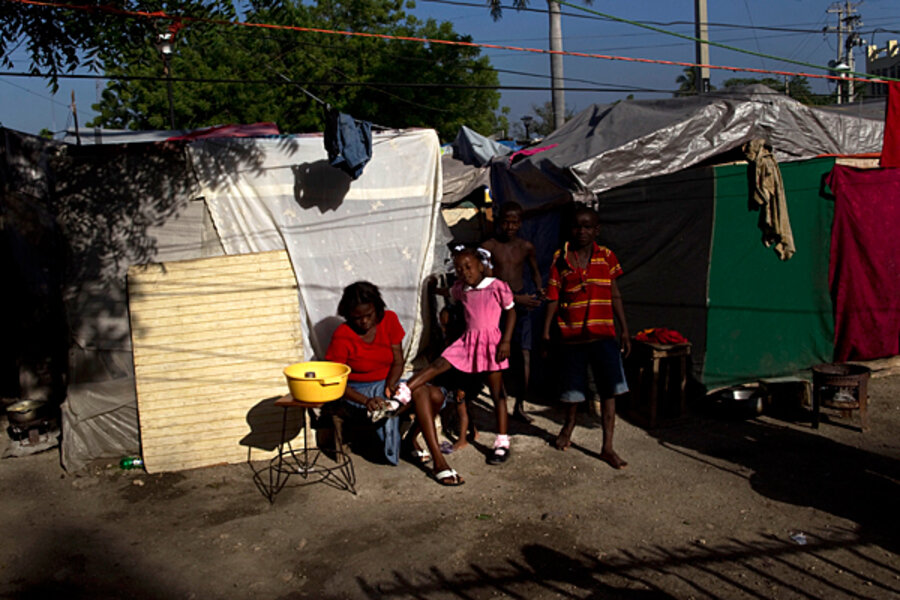Haiti relief workers try to stem rape in refugee camps
Loading...
| Port-au-Prince, Haiti
Two weekends ago, a 15-year old stayed out late with friends, trying to distract herself from the daily grind of life in one of the many tent camps that now dominate Haiti’s capital.
Just minutes after she zipped up her tent flap to turn in for the night, she heard it unzip. Five men she’d never seen before entered and told her that her evening was just about to begin.
When they were done beating and raping her, she crawled to a friend’s tent, but her friend told her it wasn’t safe to stay, so, bruised and frightened, she inched her way back home. Only at the urging of others did she eventually seek medical attention.
IN PICTURES: Relocating in Haiti
The bite on her face is fading, but the psychological scars she has suffered may be harder to heal.
The case of this teenager – who declined to be named for this article – is not uncommon in Haiti’s postquake atmosphere, where security for women is tenuous at best.
Women make up more than half the population, 67 percent of whom are single heads of household. Daily rituals such as collecting water can be a risk since the rule of law is all but absent now. Lack of legal rights, inadequate support services, impunity, and dependency – all issues before the earthquake – have become exponentially worse since the Jan. 12 temblor leveled the capital, Port-au-Prince, killing more than 200,000 and displacing more than 1 million.
How many have been raped?
The precise number of rape and domestic violence victims is difficult to determine, even with the increased presence of foreign and international medical organizations working in the camps.
Just two months after the quake, outreach workers tracked some 230 cases in 15 camps. Today there are more than 1,300 camps.
Doctors from International Medical Corps say they see at least one rape victim a day in the camps where they work.
“We’ve seen over 200 cases ourselves since the quake,” says Eramithe Delva, program director of a grass-roots organization known as KOFAVIV, the Commission of Women Victim-to-Victim. “And for every one case reported, there are multiple others that are not.”
Help is on the way
More than 200 organizations, part of the Gender Based Violence (GBV) cluster from the United Nations, are working to improve conditions for women.
During their weekly meetings at the UN compound, seated under a tent flanked by fans and two refrigerators, dozens of representatives report on their week’s activities: problems with the Haitian National Police, how to connect groups doing GBV work outside Port-au-Prince, what to do about the virtually nonexistent judicial system.
Most of the participating groups started their programs after the quake, unaware of the gains made in the movement to prevent rape, due in large part to three pioneers conspicuously absent at the table: Magalie Marcelin, Myriam Merlet, and Anne Marie Coriolan. They were killed in the quake.
The organizations which they founded, Women’s House (Kay Fanm) and Solidarity with Haitian Women (SOFA), continue to provide multiple services, including psychological support, medical aid, and safety.
Along with the United Nations Development Fund for Women (UNIFEM), they are training the Haitian National Police (often suspected perpetrators of gender-based violence) on protocol for receiving victims and will be providing them with transport needs for rapid response.
They are also working with students from the state university who hold self-defense clinics in the camp.
In partnership with the Haitian government and other groups, they have distributed thousands of postcards that list places to go for psychological and medical follow-up support.
Their biggest challenge, says UNIFEM’s Andrée Gilbert, is being able to respond to the increased need. “We are working on collecting data on the number of victims," she says. "But if what we are hearing is correct, we don’t have the capacity to respond.”
The teenager raped two weekends ago knows that all too well. She’s still looking for a place to sleep.
Related:





